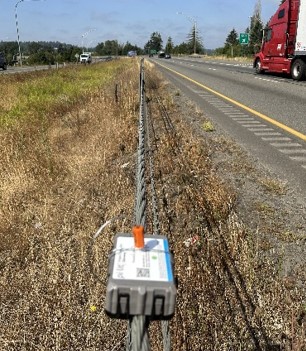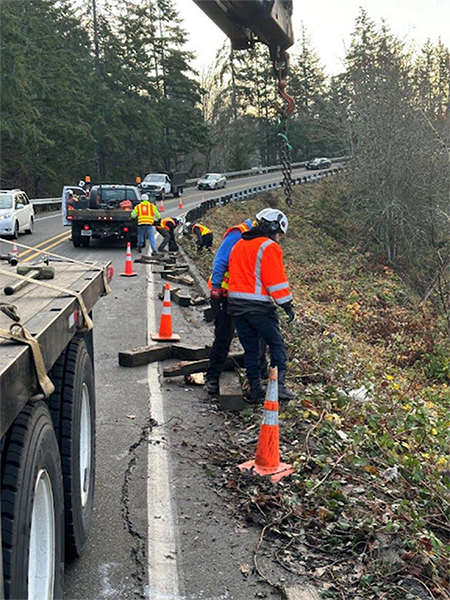Highway maintenance - HATS data collection
On this page:
HATS data collection
WSDOT's maintenance staff uses the HATS system to document daily work activities in the field and provide a clearer understanding of asset conditions as well as maintenance work is performed.
Statewide guardrail damage assessment
Source: Washington State Highway Maintenance.
Notes: This map displays the status of guardrails throughout the state, at a specific moment in time. The condition of guardrails is dynamic, meaning that although WSDOT may repair them today, they are susceptible to potential damage or changes in the future. NWR includes Island, King, San Juan, Skagit, Snohomish and Whatcom counties. NCR includes Chelan, Douglas, Grant and Okanogan counties. OR includes Clallam, Grays Harbor, Jefferson, Kitsap, Mason, Pierce and Thurston counties. SWR includes Clark, Cowlitz, Klickitat, Lewis, Pacific, Skamania and Wahkiakum counties. SCR includes Asotin, Benton, Columbia, Franklin, Garfield, Kittitas, Walla Walla and Yakima counties. ER includes Adams, Ferry, Lincoln, Pend Oreille, Spokane, Stevens and Whitman counties.
Performance analysis
2024
WSDOT assesses all state-owned guardrail, 23% are damaged
WSDOT Maintenance Operations teams assessed 100% of the 19,974 runs of guardrail in 2024 and determined 4,617 (23%) had damage—a 1% decrease from 2023, during which 4,806 (24%) were determined to have been damaged and were in need of repair. Guardrail repair and replacement include associated costs like assessment, traffic control, installation, disposal and site restoration. This statewide decrease in guardrail damage was the result of extensive efforts undertaken by all six regions and came at a cost of over $11.2 million.
WSDOT pilot project for cable barrier impact detection shows promise
With an ever-growing inventory of damaged highway safety hardware, WSDOT conducted a pilot project to assess the potential benefits of cable barrier impact detection devices in 2024. Impact detection systems are designed to monitor and respond to collisions or impacts involving the barriers used in road safety.
The cable barrier impact detection system is designed to:
- Send alerts,
- Provide real-time data to traffic management centers, and
- Measure the severity of the incident.

Impact detection devices help facilitate quicker responses to accidents by providing immediate feedback when barrier collisions occur. Additionally, real-time alerts can help improve traffic flow and reduce congestion by enabling faster responses to incidents.
The pilot project demonstrated the impact detection system effectively reported incidents and could aid WSDOT in identifying high-risk areas, and potentially recovering costs from third-party damage. WSDOT determined the devices functioned as intended and provided enough added value to investigate this technology further. Such devices could be used in corridor planning studies to help decide the types of highway safety hardware appropriate for future construction projects.
HATS data collection increases 13.9% in 2024
Maintenance technicians added 11,524 assets to the inventory and completed 279,077 records of work activities in 2024. This averages to 765 HATS (data collection software) record entries per day, a 13.9% increase from 592 records per day in 2023.
WSDOT continues to develop and enhance HATS, a tool that documents work activities in the field with 1,800 tablet computers used by agency staff. Since the HATS program started in 2008, the agency has developed a clearer understanding of asset conditions and can better track maintenance tasks performed. The system helps WSDOT better demonstrate the use of funding it receives each biennium.
2023
WSDOT assesses all state-owned guardrail, 24% are damaged
In 2023, WSDOT maintenance crews assessed 100% of the state's 20,070 guardrail lengths/runs and determined that 4,806 (24%) were damaged and in need of repair. In 2022, maintenance crews assessed 20,034 runs of guardrail and determined 4,380 (21%) had damage.
Of WSDOT's six regions, the Eastern Region had the most guardrail damage reported at 30% of all runs. South Central Region was second with 28%, Northwest Region was third with 25%, North Central Region was fourth with 24%, Southwest Region was fifth with 23% and Olympic Region had the least at 16%.
Olympic Region reduces guardrail damage with seasonal employees
To address the demands of guardrail maintenance on state highways, WSDOT's Olympic Region retained seasonal temporary employees hired for winter tasks like plowing snow and trained them in guardrail maintenance. This innovative approach allowed seven seasonal staff members to be extended into the spring/summer months, focusing specifically on guardrail work in the Tacoma area.
Trained by experienced maintenance workers, this team made significant progress, completing over 40 guardrail projects and reducing the Olympic Region's total guardrail damage from 19% in 2022 to 16% in 2023. It was the sole region in the state to make headway on guardrail repair, as over the past few years, traffic collisions and subsequent guardrail damage have increased statewide.
The decision to extend the employment of this workforce not only positively impacted the completion of essential guardrail repairs but it taught these seasonal employees skills that could assist them in transitioning into permanent employment at WSDOT.
HATS data collection increases 13.4% in 2023
Maintenance technicians added 5,435 assets to the HATS inventory and completed 244,971 records of work activities in 2023. This averages to 671 HATS record entries per day, an 13.4% increase from 592 records per day in 2022.
WSDOT continues to develop and enhance HATS, a tool that documents work activities in the field with 1,500 tablet computers used by agency staff. Since the HATS program was started in 2008, the agency has developed a clearer understanding of asset conditions and is better able to track maintenance tasks performed. The system helps WSDOT better demonstrate the use of funding it receives each biennium.

2022
HATS data collection increases 18.6% in 2022
Maintenance technicians added 4,908 assets to the HATS inventory and completed 215,912 records of work activities in 2022. This averages to 592 HATS record entries per day, an 18.6% increase from 499 records per day in 2021.
WSDOT continues to develop and enhance HATS, a tool that documents work activities in the field with 1,500 iPads used by frontline maintenance staff each day. Since the launch of HATS in 2008 followed by a major update in 2015, the agency has developed a clearer understanding of the condition of assets in the field; along with maintenance tasks performed. The system helps WSDOT better manage the funding it receives each biennium.
Data collection shows guardrail conditions
WSDOT used its maintenance management system (HATS) to complete the guardrail assessment process and obtain a point-in-time count of damage. In 2022, WSDOT maintenance crews assessed 100% of the state's 20,034 guardrail lengths/runs and determined that 4,380 (21%) were identified as damaged and in need of repair. In 2019, maintenance crews assessed 20,090 runs of guardrail and determined that 4,656 (23%) had damage. Guardrail data was not collected in 2020 and 2021 due to COVID-19 restrictions.
2021
HATS data collection increases 3% in 2021
Maintenance technicians added 6,824 assets to the HATS inventory and completed 182,109 records of work activities in 2021. This averages to 499 HATS record entries per day, a 3% increase from 2020.
WSDOT continues to develop and enhance HATS, a tool that documents work activities in the field with 1,200 iPads used by frontline maintenance staff each day. Since the launch of HATS in 2008, and a major update in 2015, the agency has developed a clearer understanding of the condition of assets in the field, along with maintenance tasks performed. The system helps WSDOT better manage the funding it receives each biennium. In 2021, a mobile cost estimating tool was deployed in HATS.
2020
HATS data collection down 18% in 2020
Maintenance technicians added 7,606 assets to the HATS inventory and completed 176,995 records of work activities in 2020. This averages to 485 HATS record entries per day, an 18% decrease from 2019.
WSDOT continues to develop and enhance HATS, at tool that documents work activities in the field with 1,200 iPads used by frontline maintenance staff each day. The agency continues to add iPads to improve the reach of HATS. Since the launch of HATS in 2008, and a major update in 2015, the agency has developed a clearer understanding of the condition of assets in the field, along with maintenance tasks performed. The system helps WSDOT better manage the funding it receives each biennium.
